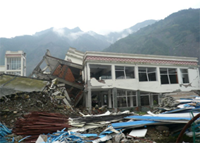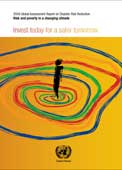Disaster risk on the rise, says UN report

- © UNESCO/T. Imamura
Worldwide, disaster risk is increasing for most hazards, says a UN report launched on 8 June at UNESCO headquarters in Paris. Moreover, the risk of economic loss from disasters is augmenting much faster than the risk of mortality.
Disaster risk is concentrated in a very small portion of the Earth’s surface and is unevenly distributed,’ observes this first edition of the biennial Global Assessment Report on Disaster Risk Reduction, entitled Risk and Poverty in a Changing Climate: Invest Today for a Safer Tomorrow. Just a handful of countries – albeit highly populated ones – have been struck by more than one mega-disaster in the past 30 years: Bangladesh, China, India, Indonesia, Japan and the USA. Although mega-disasters remain rare, half of the 14 costliest and deadliest disasters since 1976 occurred in the past five years. These include the Sichuan earthquake in May 2008, which killed at least 87 566 Chinese and affected more than 60 million. An estimated 5.36 million buildings collapsed and more than 21 million were damaged. The Sichuan earthquake was the 8th most deadly disaster in the past 30 years and the third-most costly – at US$30 billion – after Hurricane Katrina (USA, 2005) and the Kobe Earthquake (Japan, 1995). Also in May 2008, 133 655 people died after Cyclone Nargis devastated ‘the food basket’ region of Myanmar.
‘In general, poorer countries and those with weak governance are more at risk than wealthier, better-governed countries,’ notes the report, which observes that ‘small economies are more vulnerable than more diversified ones.’ When crops were attacked by locusts in Niger in 2004, the cereal harvest only dropped 11% below the 5-year average and food was available for purchase during the crisis, recalls the report. However, a combination of weak socio-economic and political structures, high market prices and growing poverty – up from 40% of the population in 1990 to 60% in 2004 – meant that 12 million people needed food aid.

Rural livelihoods are particularly vulnerable in many developing countries. Approximately 75% of those living below the international poverty line of US$1.25 per day live in rural areas: 268 million in sub-Saharan Africa, 223 million in East Asia and the Pacific, and 394 million in South Asia. ‘Even in countries experiencing rapid economic development like China,’ says the report, ‘there are 175 million rural dwellers below this poverty line.’
The report argues for a radical shift in development practices and a fresh emphasis on resilience and disaster planning. There is encouraging news in this regard. Interim national reports completed by 62 countries on progress in achieving the goals of the Hyogo Framework for Action (2005) show that many countries are making ‘very good progress in developing institutional systems, legislation, policy and plans to improve disaster preparedness, and response and early warning.’ These countries include the victims of the Indian Ocean tsunami in December 2004, which killed 226 408 people. ‘Due to such efforts, many low-income countries have dramatically reduced their mortality risk to hazards such as tropical cyclones and floods,’ observes the report.
However, progress has been less encouraging when it comes to addressing other underlying drivers of risk like the lack of access to social protection. The report observes that ‘economic growth per se does not lead to reduced disaster risk: as economies grow, exposure tends to increase at a faster rate than vulnerability can decrease. Greater social equity can not only reduce vulnerability but also alleviate poverty.’
The report was coordinated by the UN International Strategy for Disaster Reduction, in collaboration with UNDP, the World Bank, UNEP, WMO, UNESCO, the ProVention Consortium and a wide range of other partners.
Related link:
:: "Global Assessment Report on Disaster Risk Reduction" (More)
:: UNESCO Natural Disaster Reduction (website)
- Source:A World of Science, Vol. 7, N° 3 (July-September 2009)
- 03-08-2009

